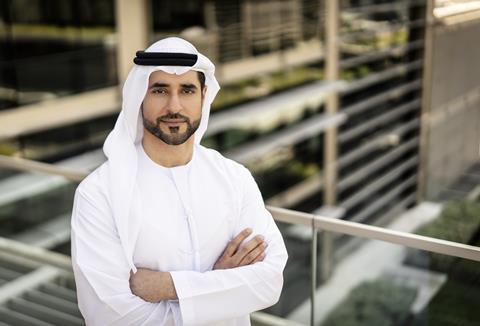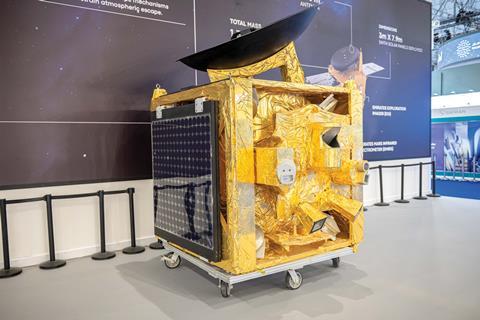The UAE has had quite a journey into the cosmos since setting up its first satellite telecommunications provider just a quarter of a century ago. As well as becoming a major player in satellite technology, the federation has ventured into space science and exploration, embarking on a Mars mission, landing a rover on the Moon (albeit not 100% successfully), and sending an astronaut to the International Space Station (ISS).
In 2028, it plans to go further, launching a spacecraft to study the asteroid belt between Mars and Jupiter.

The UAE’s motives in investing in the sector go beyond a desire for international kudos – fewer than a dozen countries can claim to be major space powers. It is part of the nation’s long effort – going back almost to the founding of the union in 1971 – to diversify from a dependence on oil and develop a knowledge and services economy.
“It is a catalyst for economic growth,” asserts Her Excellency Sarah Al Amiri, minister of state for public education and advanced technology, who also chairs the UAE Space Agency.
For most of the 26 years that the UAE has been involved in spaceflight its efforts have been led by state-owned bodies, such as the Dubai-based Mohammad Bin Rashid Space Centre (MBRSC) and local satcoms champion Yahsat. However, the UAE Space Agency – established in 2014 to develop the national space sector – recognized that contracts from occasional big-ticket government programmes were not going to be enough to encourage start-ups into the industry, says His Excellency Ibrahim Al Qasim, its deputy director general.
One initiative to counter this has been the National Space Fund, an AED 3 billion ($820 million) package to support Emirati companies in space engineering, science, and research. The first funded project will be a constellation of advanced imaging satellites using synthetic aperture radar for land-use and environmental monitoring. Named Sirb after the Arabic term for a flock of birds, the satellites will be built by a partnership of UAE public and private as well as international entities.
However, the other development that swayed many young Emiratis to become spaceflight entrepreneurs was the UAE’s Mars mission. Announced in 2014, the Hope Probe took off in 2020 and reached the Red Planet in 2021, the UAE’s 50th anniversary. “The Mars mission has helped create a generation of entrepreneurs who can serve the space industry, but also other sectors,” says Al Qasim, who notes that those behind almost half the 15 start-ups represented in the UAE space pavilion at the show are former Mars mission engineers.

However, in terms of pure economic impact, it is arguably the satellite sector that has been the biggest beneficiary of the UAE’s space endeavours. The country launched its first Earth observation satellite in 2009, and several others have followed. MBRSC is shortly to launch its MBZ-SAT, its latest satellite able to provide high-resolution imaging from space. Satellites made in the UAE now cover more than 80% of the world’s population and Yahsat is one of the global top 10 communications providers, notes Amiri.
The Mars mission – on which Amiri served as deputy project manager and science lead – was tasked with mapping the planet’s atmosphere over a Martian year (687 days). It has made the UAE just the ninth country involved in Martian exploration. The 1,350kg probe itself was developed by the MBRSC with international partners, and funding has come from the UAE Space Agency. More than 1,000 days from launch, the probe is currently in Martian orbit.
Arguably less successful was the UAE’s lunar mission, which launched in December 2022 on a SpaceX Falcon 9. The Rashid rover was meant to touch down on the in April and explore the Atlas crater. In the event, the Japanese-built lander carrying the rover lost contact in the final 10m of the descent and crashed. However, it remains the only Moon landing by an Arab country, and UAE vice president and Dubai ruler Sheikh Mohammed bin Rashid has pledged to launch a second mission, although a schedule has not been specified.
The UAE launched its astronaut programme in April 2017 to prepare an Emirati astronaut corps for scientific space exploration missions. Of the successful candidates, Hazzaa AlMansoori was chosen to be the country’s – and the Arab region’s – first representative on the ISS. AlMansoori, a former Lockheed Martin F-16 instructor pilot with the UAE air force, took off on 25 September 2019, conducting 31 scientific experiments while on board.
The UAE confirmed that the asteroid belt is its next flagship objective. A spacecraft – named MBR after Dubai’s ruler – will study seven asteroids over seven years – its aim to find out more about the origins of life on Earth. Again, while scientific knowledge is the goal, Amiri, speaking in May, said the immediate benefit would be “the creation of viable and rewarding employment opportunities for young Emiratis for generations to come…The mission will contribute to empowering local private sector companies and start-ups.”
The show’s first UAE space pavilion is a sign the country now considers itself a heavyweight, with lots to offer international partners. The UAE Space Agency also hopes it will encourage more bright, young Emiratis to enter the industry or even launch their own space technology businesses.
As Al Qasim notes: “There is no better sector to drive innovation. If you can build something for space, you can build it for any sector. And when it comes to challenges facing mankind like global warming, it is the source of many of the solutions.”


























